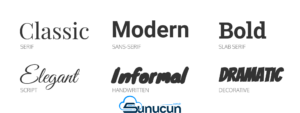What Are Fonts? Different Types of Fonts and Their Uses
Fonts are essential graphic design elements in both the digital and print media worlds. Each font tells a story and creates different impressions on readers. Fonts directly impact the readability, design aesthetics, and overall impression of any text. So, what are fonts, and what are their purposes? In this article, we will explore the definition of fonts, their types, usage areas, and how to choose the right font for your project.
What Are Fonts?
Fonts are digital design elements that define the visual style and form of text characters. Fonts allow letters, numbers, and symbols to appear in various shapes and styles. These differences determine the overall aesthetics of the font and its intended use. For example, one font may have a modern and sharp appearance, while another might be more traditional and rounded.
Fonts are used to create typographic hierarchy, improve text readability, and evoke the desired emotional response in a design. Whether in print or digital platforms, the right font choice can significantly influence the perception of a brand or content. Therefore, choosing a font requires careful and strategic consideration.

Types of Fonts
Fonts are generally categorized into four main types: serif, sans-serif, script, and decorative fonts. Each font type serves different purposes and aesthetic preferences.
1. Serif Fonts
Serif fonts are classic typefaces characterized by small lines or strokes attached to the ends of letters, known as “serifs.” These fonts typically have a more traditional appearance. Some well-known serif fonts include Times New Roman, Georgia, and Garamond.
Serif fonts are commonly used in print media and long-form texts because the serifs help the reader’s eye follow the text more easily. Newspapers, books, and magazines often use serif fonts for this reason.
2. Sans-Serif Fonts
Sans-serif fonts, as the name suggests, do not have small lines or strokes (serifs) at the ends of the letters. These fonts have a more modern and clean appearance. Helvetica, Arial, and Verdana are popular sans-serif fonts, frequently used in digital platforms like websites, mobile apps, and corporate designs due to their minimalist and uncluttered look.
Sans-serif fonts are ideal for both long-form text and headlines in digital environments due to their high readability. Additionally, since they take up less space, sans-serif fonts are perfect for tight spaces.
3. Script Fonts
Script fonts resemble cursive handwriting and are elegant and flowing. They are often used in invitations, logos, or special event designs. Script fonts can add a formal and stylish touch to a design, but they are not suitable for long texts due to readability challenges. Pacifico and Brush Script are well-known script fonts.
4. Decorative (Display) Fonts
Decorative fonts are designed with a specific theme or aesthetic in mind. These fonts are typically used for posters, advertisements, or headlines to grab attention. Decorative fonts help create a unique atmosphere for a design, but they are not suitable for long-form text due to low readability. These fonts are often used sparingly for specific projects where a distinctive look is required.
Font Usage Areas
Fonts are used in various fields, and the right font choice can significantly affect the success of a design. Here are some common areas where fonts are used:
- Digital Media: Websites, mobile apps, and social media graphics often utilize sans-serif and modern serif fonts. When choosing fonts for digital media, readability, screen sizes, and user experience must be considered.
- Printed Publications: Books, magazines, newspapers, and brochures typically prefer serif fonts. Serif fonts are favored for long texts because they improve the flow and readability of the text.
- Logo and Brand Identity: The fonts used in a brand’s logo and overall identity reflect the image and values of the brand. Script and decorative fonts are often used in logos to add uniqueness and personality to a brand’s identity.
- Advertising and Poster Design: In advertisements and posters, eye-catching decorative fonts or large sans-serif headlines are often employed. These designs aim to quickly grab attention and convey a message in a short time.
How to Choose the Right Font?
Choosing the right font can significantly impact the overall success of a design. Here are some important factors to consider when selecting fonts:
- Readability: The readability of the font is paramount. No matter how beautiful the design is, if the text is difficult to read, it will fail to achieve its purpose.
- Appropriateness: The font you choose should be appropriate for the content. For instance, the font used in a formal document should not be the same as the one used in a children’s book.
- Balance: When using different fonts together, ensure they complement each other. Typically, a different font is chosen for headlines and body text, but these fonts should work well together.
- Aesthetics: The font should match the overall design aesthetics. Fonts should be chosen to enhance the tone and message of the design.
Conclusion
Fonts are one of the most critical components of any design. The right font choice directly influences the success of a design, whether in digital or print media. Fonts help define a brand’s identity, enhance the readability of a text, and shape the overall aesthetic of a design. Therefore, choosing a font should involve careful consideration of both aesthetics and functionality.




